- Table of contents:
- Urus curriculum
- Urus trails
- Urus plans
- Urus favourites
- Urus staff
Urus curriculum
Conceived of in 2015, Urus is an expert yet somewhat idiosyncratic guide escorting the interested academic and general user through the domain of the production and reception of early modern prints, with a particular focus on integrating the material from Central and Eastern Europe into a global context. The database takes its name from the aurochs, or urus in Latin―a now extinct species of large wild cattle. The urus was described in Caesar’s Gallic Wars and mentioned in the Nibelungenlied, and subsequently acknowledged in many mediaeval and early modern encyclopaedias. However, in the Middle Ages, the aurochs was becoming rare, and by the sixteenth century its habitat was limited to remote corners of Europe: Prussia, Masovia, Lithuania, and Muscovy. As a consequence, pre-modern authors found the urus in several respects more intriguing than some animals of Africa, Asia, and even the Americas. Indeed, the zoology scholars lived in permanent want of reliable sources and tirelessly asked various informants in Eastern Europe to provide them depictions of the aurochs, which were often mixed up with the wisent―another big bovid typical of the local fauna.
Taking the aurochs―a large and robust, but also somewhat obscure and restive beast―as the model, the Urus database is conceived of as providing a powerful tool for contemporary print scholars, offering them insight into the Eastern European material. In particular, the database collects:
impressions (woodcuts, engravings, and etchings; single prints and illustrations for books and pamphlets) produced in the region;
printing matrices (woodcut blocks and copperplates, both preserved and unpreserved) used by the local printmakers;
graphic prototypes and models for works created in Central and Eastern Europe;
details of local artists, publishers, owners, collectors, or addressees of prints; and
depictions of local persons, places, events, plants, and, of course, animals.
These and other records are linked by way of their various properties and diverse relations, including iconography, chronology, geography, and interactions among images.
Between 2016 and 2019, when it was in its infancy, Urus attended what might be called an experimental nursery, operating within the framework of the research project Reframed Image: Reception of Prints in the Kingdom of Poland from the End of the Fifteenth to the Beginning of the Seventeenth Century, generously financed by the National Science Centre, Poland (no. 2015/17/B/HS2/02469). Subsequently, in 2019, Urus enrolled itself in primary school, also supported by the National Science Centre as part of the research project Matrix of Confusion: The Production of Woodcut Illustrations in Poland–Lithuania and Prussia until the Early Seventeenth Century (no. 2018/31/B/HS2/00533). As of autumn 2022, Urus serves as a digital guide to the world of Central and Eastern European early modern prints and printmaking while pursuing its own higher education career (see Urus plans). Starting in autumn 2024, it is being further expanded as part of the ERC Advanced Grant project, “Scholars, Animals, Images, Geographies, and the Arts: De-exoticizing Eastern Europe in the Early Modern Period” (SAIGA, Grant agreement ID: 101141906).
Urus blazes trails that are marked with respective colours (see Urus trails). Along the way, Urus grazes freely in diverse pastures of production and explores sometimes convoluted thickets of reception rather than methodically cultivating the soil within strictly defined rows and field boundaries. A faithful companion to its Caretakers, Urus roams the fields of printmaking alongside them, investigating with them assorted areas of its fields with varying degrees of curiosity and accuracy. It has inspected some realms quite comprehensively, and on some occasions has even ventured beyond its native regions, while in several corners of its habitat it has as yet left no footprints.
Trained staff members, tame it, and take care of its health and well-being, but they are unable to keep an eye on every single detail. Therefore, if you notice any inappropriate behaviour by this somewhat unruly beast, especially if you suspect Urus is misleading you, please let the Head Keeper know at g.jurkowlaniec@uw.edu.pl. Also, if you would like Urus to visit a certain spot or go down a particular path, you are invited to approach the Head Keeper with suggestions for the near future.
Nota bene:
Urus catalogues its content by, among other divisions, Things, Actors, Iconographies, and the like. Some names of Things, objects of Nature, Actors, Iconographies, and Places may be strikingly similar or even identical; however, each refers to a different kind of object. Most of these objects are mutually linked, but some are not yet, because Urus is currently working on some relationships (see Urus plans). For instance, there is a church in Cracow called “Royal Archcathedral Basilica of Saints Stanislaus and Wenceslaus (Wawel Cathedral)” which is, obviously, a work of architecture, also a Thing. This Thing is linked with the homonymous Place that indicates its geographical coordinates. Since Urus has collected some images that depict this very church, the Thing is also related to the Iconography called simply “Wawel Cathedral”. Moreover, there is an Actor, a corporation, whose official name is “Cracow Cathedral chapter”, which is linked with both the respective Place and a respective record of Iconography: the coat of arms (“Aaron”) that may be found on many images housed in the Urus database.
Things Trail (Material, inanimate objects, mostly works of art, both preserved and unpreserved)
By far the longest and most travelled route, with innumerable eye-catching exhibits and thought-provoking spots; generally easy to navigate, with very few twists that need extra attention.
The Things in the Urus database are man-made objects, in the most part (ca 66%) graphic impressions: single-sheet prints and book illustrations; printing matrices (ca 25%), both preserved and unpreserved; copies of illustrated books (ca 5%), both printed and handwritten; and also paintings, sculptures, parts of buildings, and other works that inspired prints, were inspired by graphic prototypes, or were represented on printed images.
Legend to the Things Table: The simplest access to the Things Table is through the respective gate on the main page.
By default, the Things Table is ordered by the most recently edited items and shows three columns: the Thing’s Label, the Type it represents (e.g. “printing: impression”, “painting”, etc.) and a thumbnail of the digital Image, if present in the database. Depending on your interests, you may adjust the table view by unhiding further columns. You may also filter Urus’s resources by various attributes of Things.
Nota bene:
There are neither separate columns nor filters for people or localities, as these objects have their own routes of Actors and Places. However, the Thing’s label typically comprises the Things’ name, given in bold, but also other elements, such as names of people or places.
For instance, if you enter “Urus” into the search box, you will receive all Things whose label contain the string “urus”, including, e.g., Hipocentaurus. One of these will be an Urus by David Kandel—specifically, an impression in a copy of one of the editions of Sebastian Münster’s Cosmography. A search for “Sebastian” in the Things Table will obviously return many depictions of St Sebastian and a portrait of Sebastian Münster, but also many impressions whose labels include the name of Sebastian Münster as an author of Cosmography. By the same token, a search for “Basel” in the Things Table will return some representations of basil, as they are titled “Baselicon” in their original contexts, but also many Things whose labels include the city of Basel as a place. However, if youe enter both "urus" and "basel" into the search box, you will receive a few Things whose labels include both respective strings.
Obviously, you will also find Sebastian Münster in the Actors Table, and the city of Basel on the Map of Places.
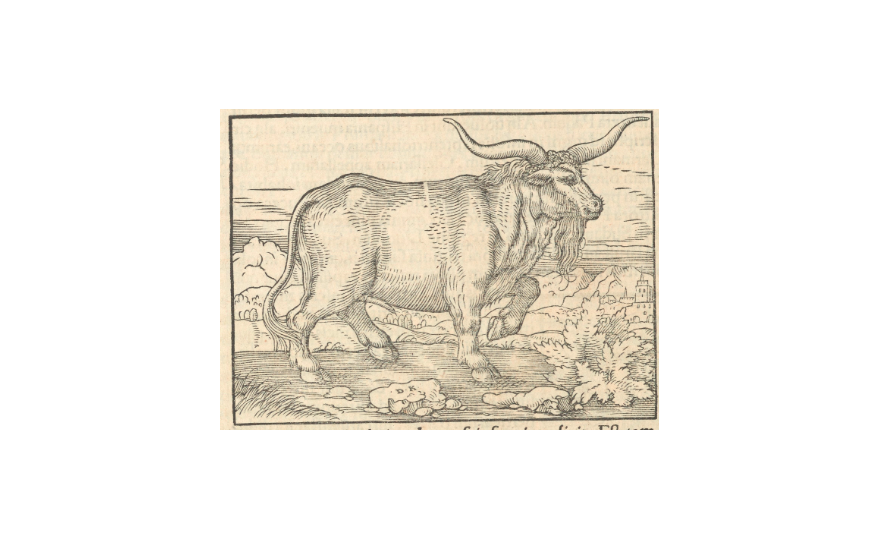
David Kandel (printmaker), Aurochs (Taurus sylvestris, Urus). In Sebastian Münster, Cosmographiae universalis Libri VI, Basel: Heinrich Petri (printer), January 1550 - March 1550 (BCzart, MNK, Cracow)
urus + basel in Things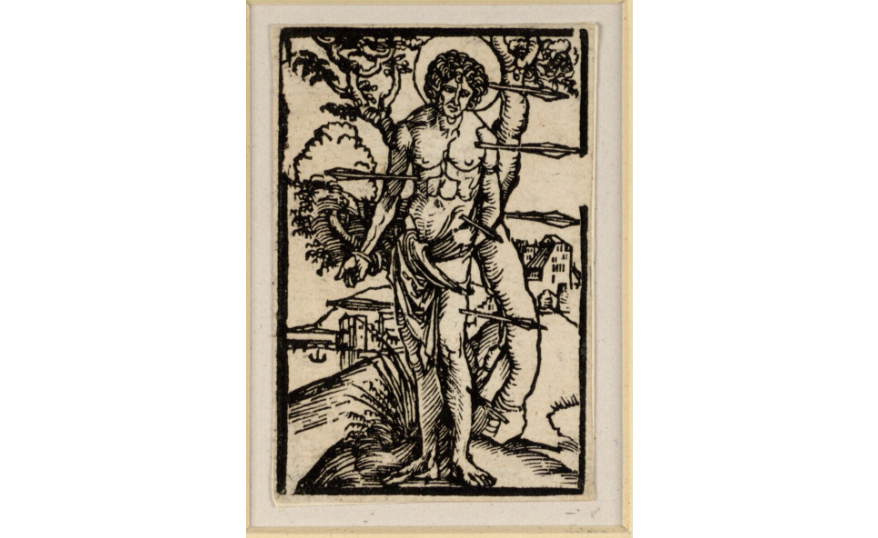
Albrecht Dürer's workshop (printmaker), St Sebastian, (Albertina, Vienna)
Sebastian in Things Sebastian in Actors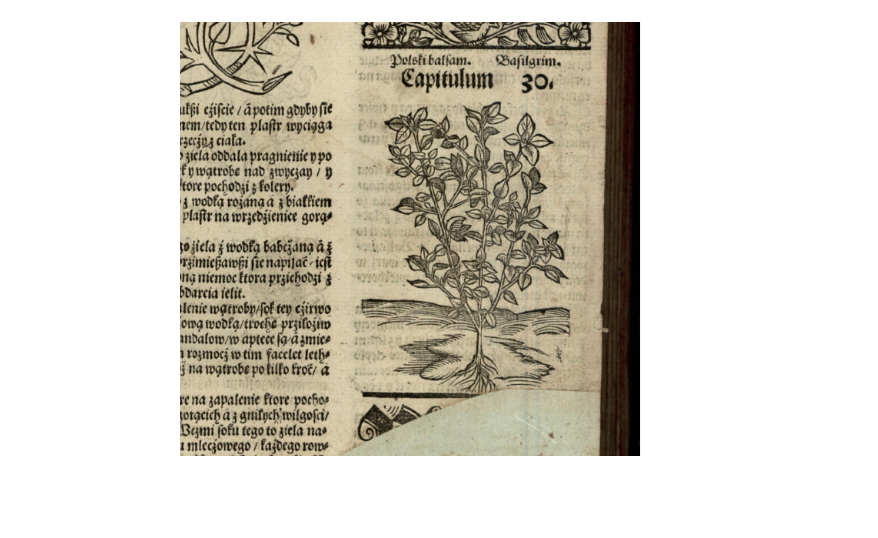
Basil (Baselicon, Polski balsam, Basilgrim). In Hieronim Spiczyński, O Ziolach tutecznych y zamorskich y o mocy ich, Cracow: Helena Ungler (printer), 1542 (BN, Warsaw)
Basel in Things Basel in PlacesLegend to Particular Things’ Cards: Each Thing has a number beginning with “T”, displayed on a respective card that provides detailed information on the object’s properties. At the same time, the card is a node linking the given Thing with various Actors, Places, Works, Interactions, or Iconographies (and occasionally also Narratives and Functional Contexts). Thus, the Thing’s card is also a spot where you may change course in the trail: e.g. from Things to Actors. You may also return to the Things Table by clicking “Things” in the header of any card from this domain.
Nota bene:
Many Things’ names have various additions in parentheses. Some additions, in particular those pertaining to book illustrations, render the original reading of the caption of a given image, especially if the identification of the represented object is not self-evident. Some addenda, in particular those pertaining to printing matrices, indicate the state and users of a given woodblock or copperplate.
The matrices, but also other Things that underwent any significant modification, are captured in their respective historical states. Each state is recorded as a separate object in the database, also has its own number and, consequently, a separate card. Such objects are, obviously, linked with those representing the previous or following states. In this way, it is possible to refer each impression back to the respective state of the matrix, and also to distinguish printers who used the one matrix in various states.
Depending on circumstances, some designs are recorded in one sole, more or less random impression, whereas others are documented in many impressions: e.g. in various copies of one edition of the same work. This is because the former are relevant as graphic prototypes for further works (and so a more or less random impression is given as an example), whereas the latter were collected for some noteworthy qualities of those particular impressions or of the book copies in which they are included.
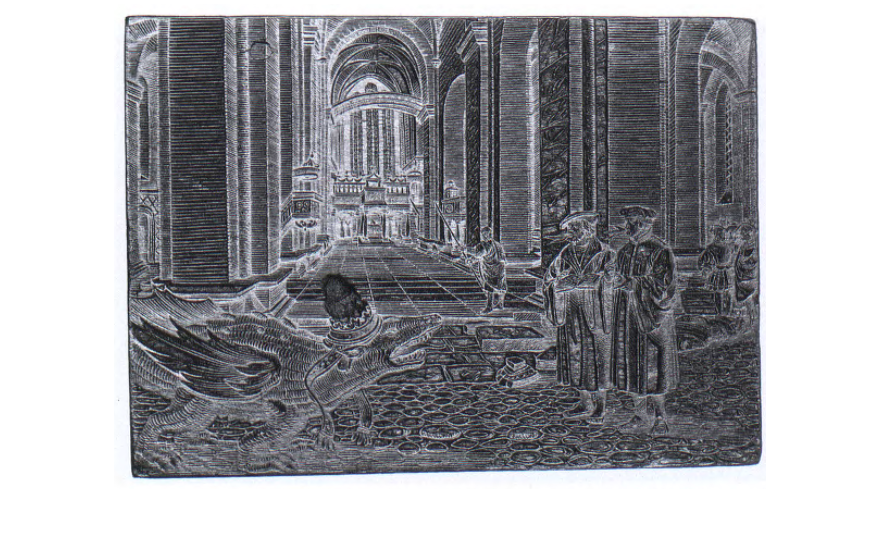
Two Witnesses and the Beast (state II/III) (Severín, Melantrich, Szarfenberger), Part of Bible cycle (Lufft; Severin; Melantrich; Szarfenberger; Siebeneicher)
Two Witnesses and the Beast in ThingsNature Trail (Present taxonomy of biotic and abiotic resources)
A narrow path leading through the contemporary landscape of scientific Latin names for plants and animals, as well as names of metals and minerals. A hierarchical chart allows you to find the appropriate category and navigate to a suitably filtered table of Things containing respective representations.
Words Trail (Texts, both printed and handwritten)
Legend to Words Table: This table comprises three tabs: Publications, Works and Inscriptions, each equipped with various filters. By default, this table is sorted by last-edited records, and it still a work in progress.
Nota bene:
Urus interprets Publications as printed editions or manuscripts of Works. The labels of Publications are given as they appear on the respective title pages, whereas standardised modern transcription or the unified titles are used in the labels of Works. For instance, Conrad Gessner’s Icones animalium quadrupedum appear as “Icones animalium quadrupedum” in the list of Works, whereas specific editions of this work, recognised among the Publications, are titled “Icones Animalivm Qvadrvpedvm Viviparorvm Et Oviparorvm ...”. Typically, particular copies of specific editions included among Things have identical labels to their respective Publications.
Legend to Particular Words’ Cards: Each Work has a number beginning with "W", displayed on a respective card that indicates various attributes of the given literary text, particularly the people involved in its creation, possible other versions or parts, and its documentation—manuscripts or printed editions—referring to Publications.
Each Publication has a number beginning with "Pb"; the card encompasses most of the information from the Work card, adding data on the people and places associated with the publication, along with additional attributes such as its format. It also links to the in-Urus copies, which are, of course, categorised as Things.
Individual exhibits along this route are accessible through nodes along the Things, Actors, or Places Trails. In particular, each book copy is a Thing intrinsically connected with the domain of Words. Therefore, a card of each book copy provides access to the card of the respective literary work and its specific publications, as represented by the given copy.
For instance, the card of one of the copies of the Latin edition of Münster’s Cosmography gives you direct access to the card of the respective literary work. The header of the same card of the book copy gives you access to the respective edition (Publication) of Münster’s Cosmography where you will find out more about this particular edition.
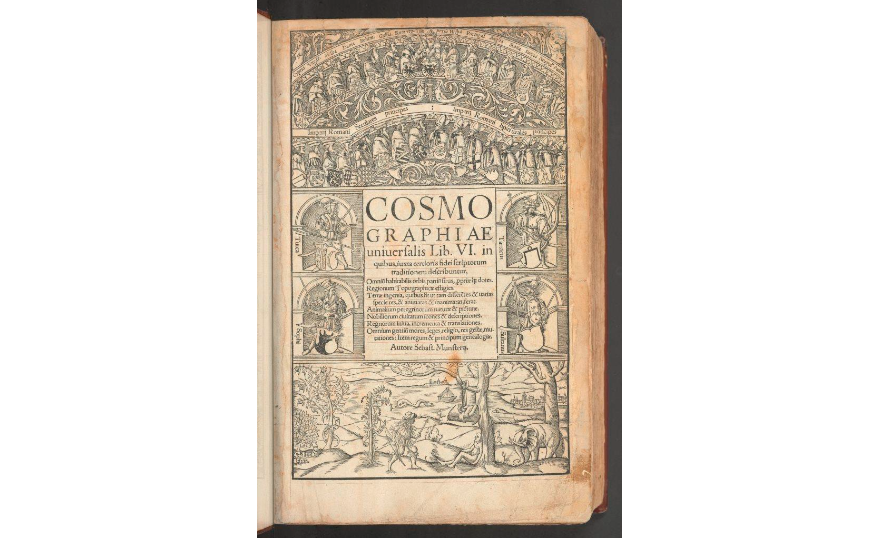
Sebastian Münster, Cosmographiae universalis Libri VI, Basel: Heinrich Petri (printer), January 1550 - March 1550 (BCzart, MNK, Cracow)
Book copy in Things Literary work in Words Publication in WordsActors Trail (Persons, groups, and corporations, both contemporary and historical)
A popular route, probably the easiest and the most intuitive. The gate on the main page gives you access to the table of Actors―both human and non-human―playing various roles in the process of production and reception of prints (artists, publishers, owners, collectors, or addressees of prints, not forgetting authors of literary works and persons depicted in printed images or represented via coats of arms).
Legend to Actors Table: By default, this table is ordered alphabetically by family names, with a few exceptions, such as kings and princes ordered by their first names and popes ordered by their papal names. The names are typically rendered in the form widespread in English (so: Albert of Prussia, not Albrecht of Prussia; Thomas Cajetan, not Tommaso De Vio), with various alternative readings provided, when appropriate.
Legend to Particular Actors’ Cards: Each Actor has a number beginning with “A”, displayed on a respective card that includes essential information and gives access to related Iconographies (in the most part coats of arms or likenesses), Things (not only created, but also owned by the Actor), literary Works or their specific Publications (not only produced by this Actor but also, e.g., dedicated to them), and also Mentions concerning this Actor (the latter relationships usually refer to the inscriptions on printing matrices or, occasionally, on other kinds of Things).
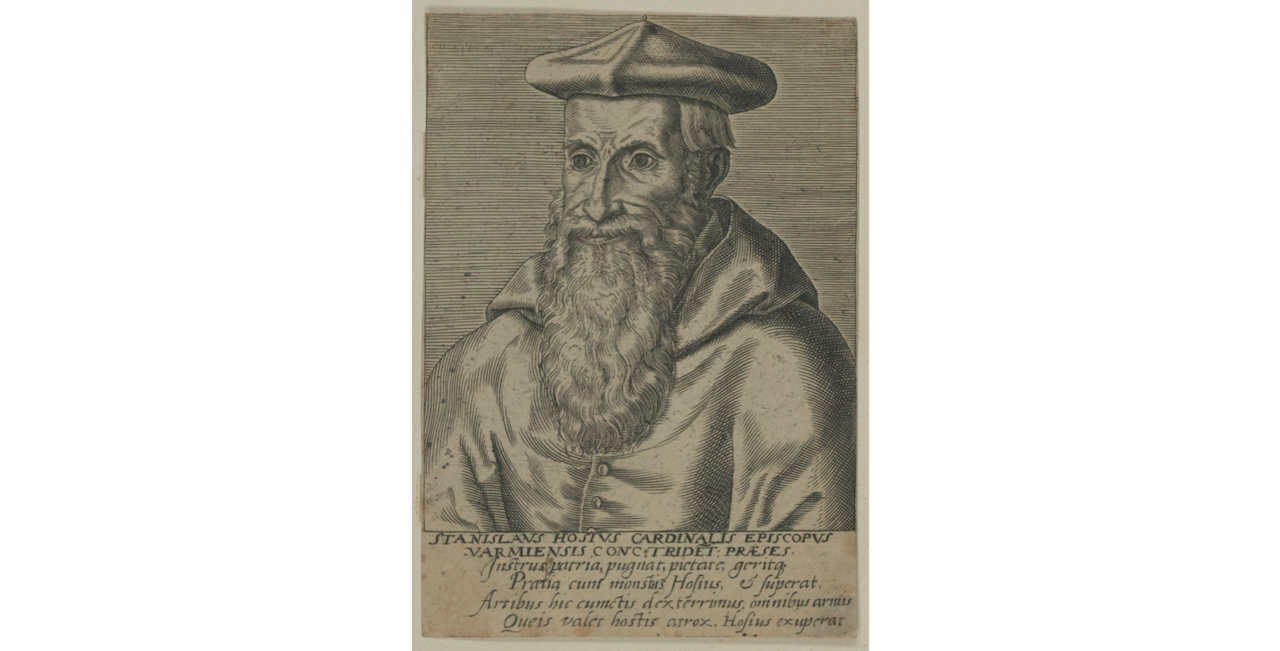
Philips Galle (printmaker), Stanisław Hozjusz , (GNM, Nuremberg)
Hozjusz in Actors Hozjusz in IconographiesInteractions Trail (Chains of relationships among images)
The gate to the Interactions Trail is now open, but the search engine is still under development. However, the exhibits along this route are accessible in two ways in section "In-Urus interactions" of Thing cards. This section provides a list of recorded direct sources or descendants of the given design. On the card of Thing "A"
⇥ B
means that "A" influenced "B"
⇤ B
means that "B" influenced "A".
Below the list, the card displays the corresponding fragment of the graph of interactions. While this fragment can be analyzed within the card itself, more specialized searches can be conducted by clicking the "Expert view" button, which opens a section of the graph in a new window.
Legend to Interactions Graph: The graph allows users to interact with nodes, reorganise them, and filter data sets. Clicking on a node reveals basic information and, if available, a thumbnail of the respective image. Also there is a possibility to download .csv files—a function that is particularly valuable for analyzing dense datasets, such as series including hundreds of items, each linked with items from other sets.
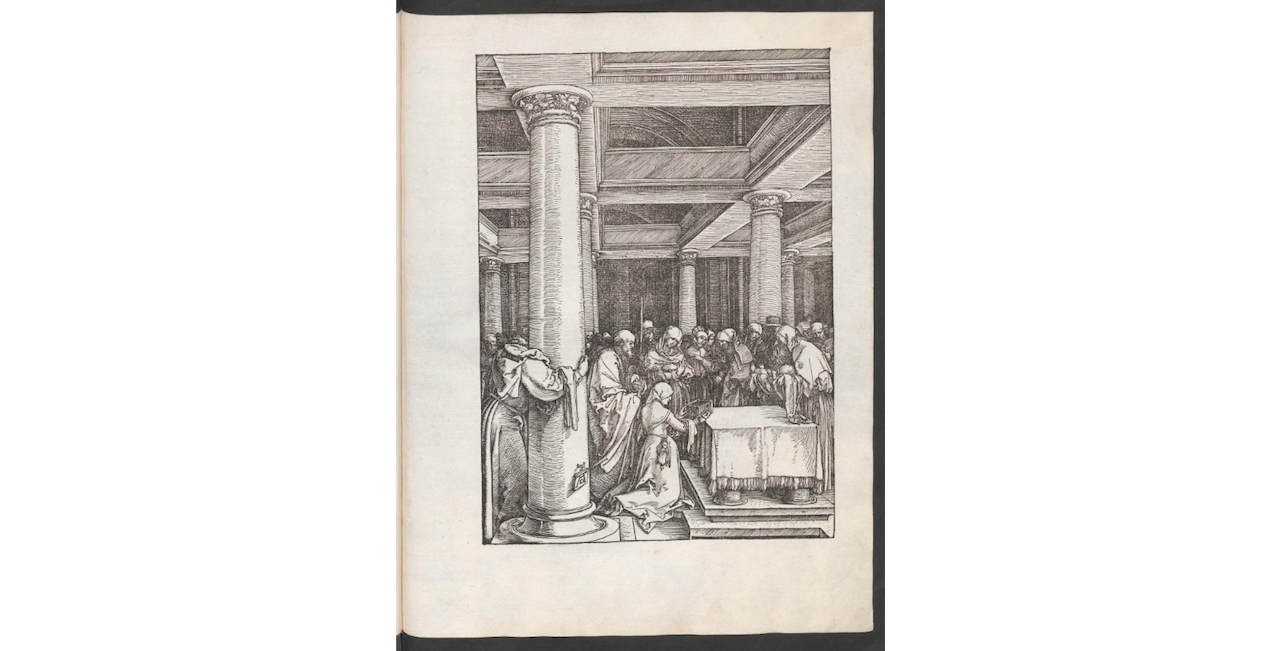
Albrecht Dürer (printmaker), Presentation of Christ in the Temple. In Benedictus Chelidonius, Epitome in divae parthenices Mariae historiam ab Alberto Durero Norico per figuras digestam cum versibus annexis Chelidoni, Nuremberg: Hieronymus Höltzel (printer), 1511 (SBB, Berlin)
Explore Interactions via ThingsIconographies Trail (Iconographic subjects, some related to Narratives, Functional Contexts and Captions)
This exceptionally steep, narrow, and rocky trail has been pre-surfaced, with much work still ahead.
The primary view employs an Euler diagram, illustrating relationships among Iconographies. You can explore this diagram, utilise the search box in the upper right corner, or opt for the Expert view for more intricate queries.
Whether beginning with circle exploration or search box input, selecting a value initiates a deeper dive into the diagram. The narrower categories are represented by potentially overlapping blue circles, while broader categories are represented by blue triangles distributed around the main field. The filtered diagram includes a header providing access to the card of the specific Iconography, offering information on related Functional Contexts, Narratives, Captions, and entities like Actors, Places, or Things.
For advanced searches, the Expert view provides a robust search mechanism. Note that the “Search Iconographies” box accepts multiple values (by default linked with "and"), while "Narratives," "Functional contexts," and "Captions" boxes only accept one value. Please consider that the features of Narratives, Functional contexts, and Captions are still under testing.
Iconographies are hierarchically arranged, and the "Include narrower iconographies" checkbox enables you to refine the search scope. You can tailor searches by including or excluding narrower categories and specifying Narratives, Functional contexts, or Captions linked to the given iconography. The resulting filtered table displays Iconographies, Narratives (if acknowledged), Functional contexts (if acknowledged), Captions (if acknowledged), and, most importantly, a number – a quantity indicator for Things. Clicking this number takes you to a detailed table of relevant Things.
The exhibits on the Iconographies Trail are accessible along the Actors, Places and Things Trails. Many cards of Actors and Places include references to related Iconographies, typically to respective coats of arms or likenesses. More elaborate is the Iconographies section in the cards of Things, which often (especially in book illustrations) includes not only Iconography descriptions (sometimes collecting several motifs under one umbrella), but also a Narrative (referred to the associated story, which sometimes is indicative of, but sometimes, on the contrary, utterly inconsistent with the subject of the represented scene), Functional Context (indicating genre or a particular section or chapter, especially regarding works with standardised structure, such as the Bible or liturgical books) and a Caption.
Each value in Iconography Description, Narrative, Functional Context, or Caption grants access to a corresponding card. These cards include a blue button inviting exploration of the selected Iconography, Narrative, Functional Context, or Caption via Things. Clicking this button leads to a filtered table of Things related to the chosen Iconography, Narrative, Functional context, or Caption.
For example, the card of Iconography “Warning Against False Prophets” will take you to a table of all scenes related to this Iconography, many included in postils and accompanying the respective narrative for the Eighth Sunday after Trinity, but some placed in other contexts, or lacking context altogether. By the same token, under the Functional context of “8th Sunday after Trinity” you will discover all instances of images related to this context acknowledged by Urus so far. Most of these will, as you may expect, represent the Warning Against False Prophets scene, but some will be generic scenes with Christ Explaining His Doctrine to the Apostles or, apparently misconceived, depictions of Christ Instructing the Disciples on Reconciliation.
Urus extensively relies on, but also elaborates upon, the classification provided by Iconclass. In particular, Iconographies are ordered hierarchically and for the most part follow the Iconclass structure and labels. However, Urus has also simplified some labels and distinguished various motifs that are not covered by Iconclass (e.g. “Letter of indulgence”).
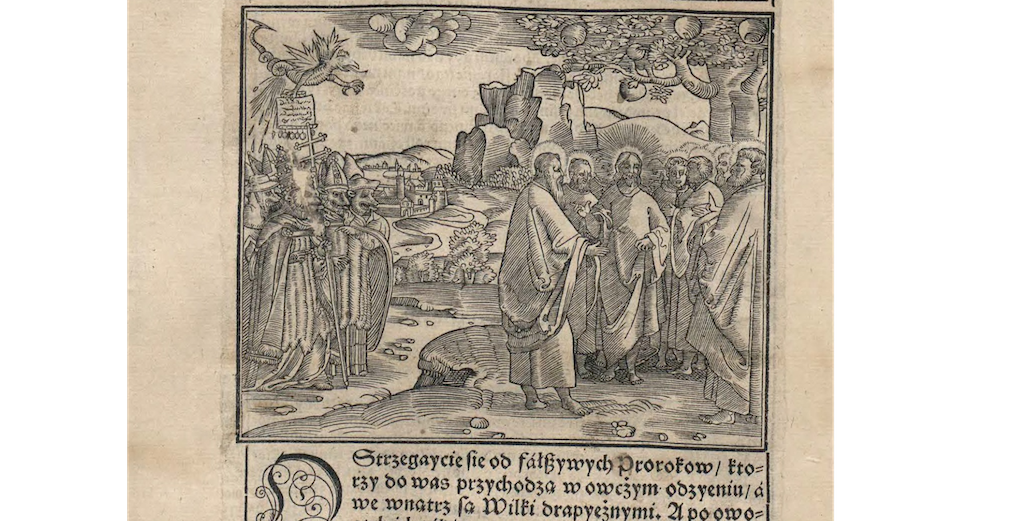
Monogrammist I.C.B. (blockcutter, attr.), Warning Against False Prophets. In Mikołaj Rej, Świętych słow a spraw Pańskich ... Kronika, albo Postilla (var. B), Cracow: Maciej Wirzbięta (printer), 1 January 1556 - 5 January 1557 (BJ, Cracow)
Explore Iconographies via Things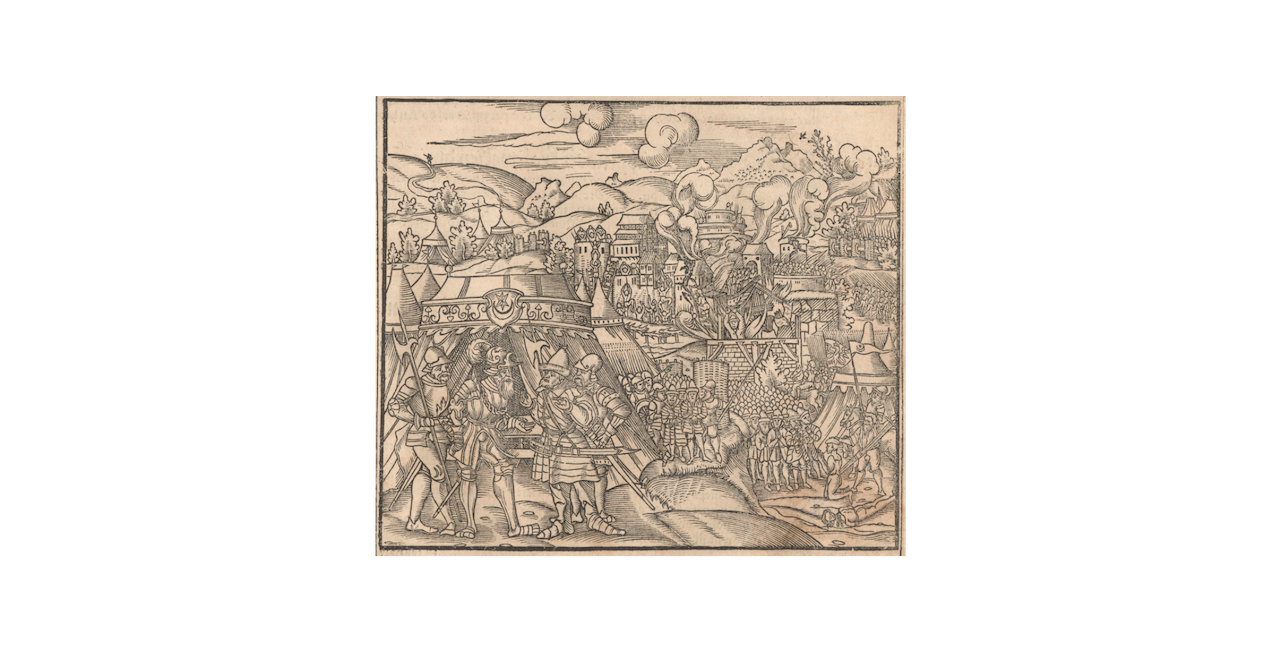
Siege of Starodub. In Marcin Bielski, Kronika to iest Historia Swiata, Cracow: Mateusz Siebeneicher (printer), 1564 (BCzart, MNK, Cracow)
Starodub in Places Starodub in Iconographies via ThingsPlaces Trail (Map and list of localities and narrower spots, e.g. specific buildings, both contemporary and historical)
By default, the gate to this trail opens the Map, which, however, also includes a search field where you may enter the name and see if it is known to Urus.
Legend to Map of Places: All Places are anchored in geographic coordinates and thus may be found on the Map, where they are represented by blue dots. The bigger ones collect multiple Places, which you may explore by zooming the map or just clicking on the chosen dot, sometimes repetitively—i.e. until you have reached a close-up that only collects the smallest dots distributed throughout a given area.
The small dots representing single Places function in a three-level hierarchy:
entire localities, which are represented by the dots placed in the centre of a given location (e.g. main square) and distinguished with an additional circle around them (e.g. Lviv)
narrower spots, typically buildings (e.g. Borys Voznytsky Lviv National Art Gallery)
(sometimes) a specific location within a given building (e.g. Cracow Envoys Hall in Wawel Castle).
Legend to Particular Places’ Cards: Each Place has a number beginning with “P”, displayed on a respective card that, by default, appears as the map’s side panel. However, if you wish to focus on the lists of objects related to the chosen location, you may easily hide the map.
Whenever appropriate, a Place card gives access to various pertinent Iconographies and below there is a section typically divided into two or three tabs:
Creation Place, which collects the lists of Things, Works, or Publications created in the given Place (typical of localities rather than specific buildings)
Storage Place, which collects the lists of Things stored in the given Place (typical of buildings or their specific parts rather than entire localities)
Related Places, which situates the object in the hierarchy of Places (indicating its parent and contained places, where applicable).
Nota bene:Regarding exceptionally highly networked Places, the system may need some time to refresh the view, as is the case of Cracow, which is linked to various Iconographies, Publications, and literary Works, but above all to thousands of Things, in particular woodblocks, produced therein.
Timelines Trail
In preparation
Urus plans
Currently, Urus is pursuing its own path of further education in the domains of Things, Actors, and Places, focusing on various ways of grouping Things, mutual relationships between Actors and Places, and also a distinction between contemporary and historical Places.
At the same time, Urus is intensively developing its own entry qualifications to higher education in the fields of Iconographies and Interactions. Concerning the former, Urus is now being trained in the hierarchies of iconographic subjects and their references to various narratives and contexts. Particular challenges Urus is currently coping with relate to coats of arms, emblems, and other devices. One group of problems arises out of the polyvalence of many motifs and a variety of entities sharing the same emblem (e.g. Lorraine cross). Another array of issues is tied up in the complexity of some heraldic devices (e.g. quarterly coats of arms, as in Giacomo Lauro, Communion of St Stanislaus Kostka and scenes from his life). Most importantly, a complex coat of arms is not regarded as a mere sum of individual motifs, but a separate Iconography, being, at the same time, a subcategory of all respective Iconographies:
Simultaneously, Urus elaborates on the systematics of Narratives and Functional Contexts. The point of departure for these developments are Narratives drawn from the Bible and Functional Contexts referring to particular Sundays or feasts of the liturgical year. In this domain, the feature at present facilitates various investigations concerning liturgical books or postils. Currently, Urus is working on how to apply this system to other kinds of accounts and diverse text genres.
With respect to the Interactions, Urus has recently considered several tools that might be used to represent chains of inspiration among works of visual arts, and also between images and narratives. Unfortunately, none of these external tools proved adequate for Urus needs. Urus intends, therefore, to develop an original chart of Interactions, although this will probably take some time.
Paradoxical as it may seem, Urus has not hitherto demonstrated sufficient expertise, at least not to its Head Keeper’s satisfaction, in the realm of Nature.
Likewise, Urus has not yet found an adequate way to represent various developments along one or more Timelines.
Regarding specific skills, Urus is able to export some datasets to .csv files, but this feature is only accessible on a very basic level for now. Urus does diligently note various alternative forms of proper names and titles but has not yet learned how to use this data while searching for specific objects. Finally, for the time being, like an ox tormented by stinging insects, Urus is incurably sensitive to diacritics.
Urus is a keen student who is extremely strongly motivated to develop its features, improve its skills, and overcome its impairments, but its further curriculum heavily depends on feedback from the community, along with, it goes without saying, funding.
Urus favourites
In its early years, Urus participated in many study trips that resulted in publications authored by various team members. Among the keepsakes of these excursions are, above all:
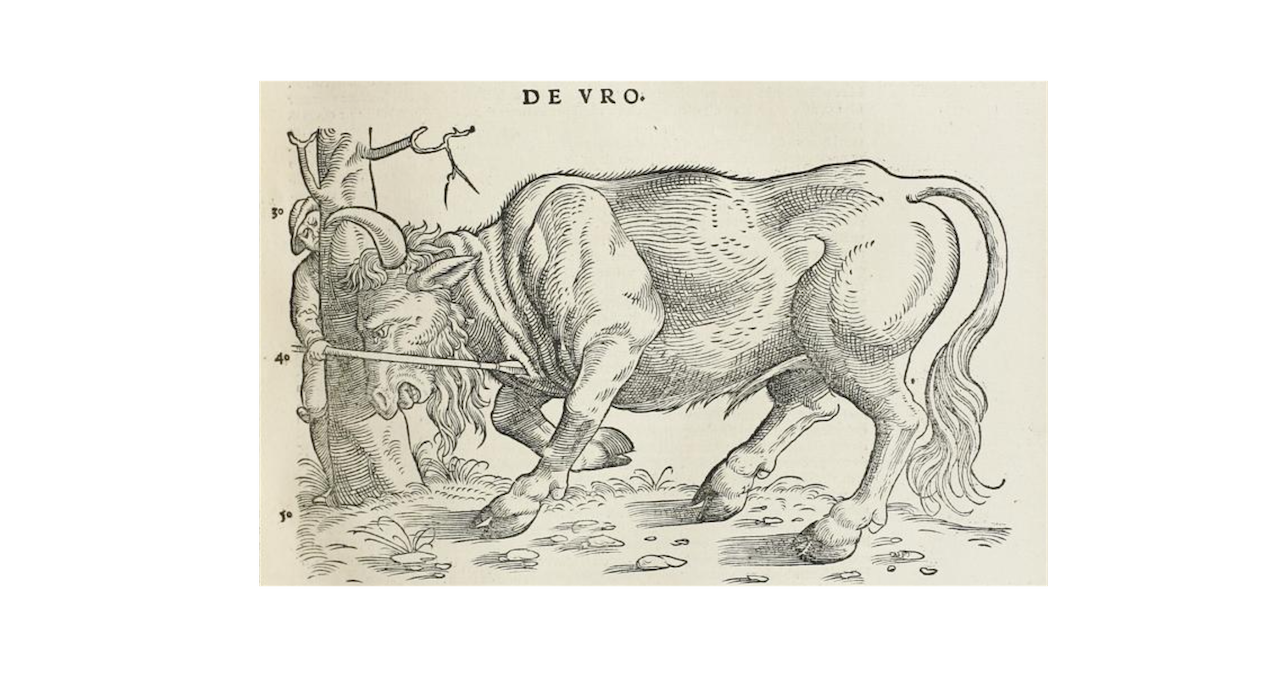
Hunting Aurochs. In Conrad Gessner, Historiae Animalium Liber I de Quadrupedibus, Zürich: Christoph Froschauer (printer), 1551 (ULB, Halle)
Explore in Things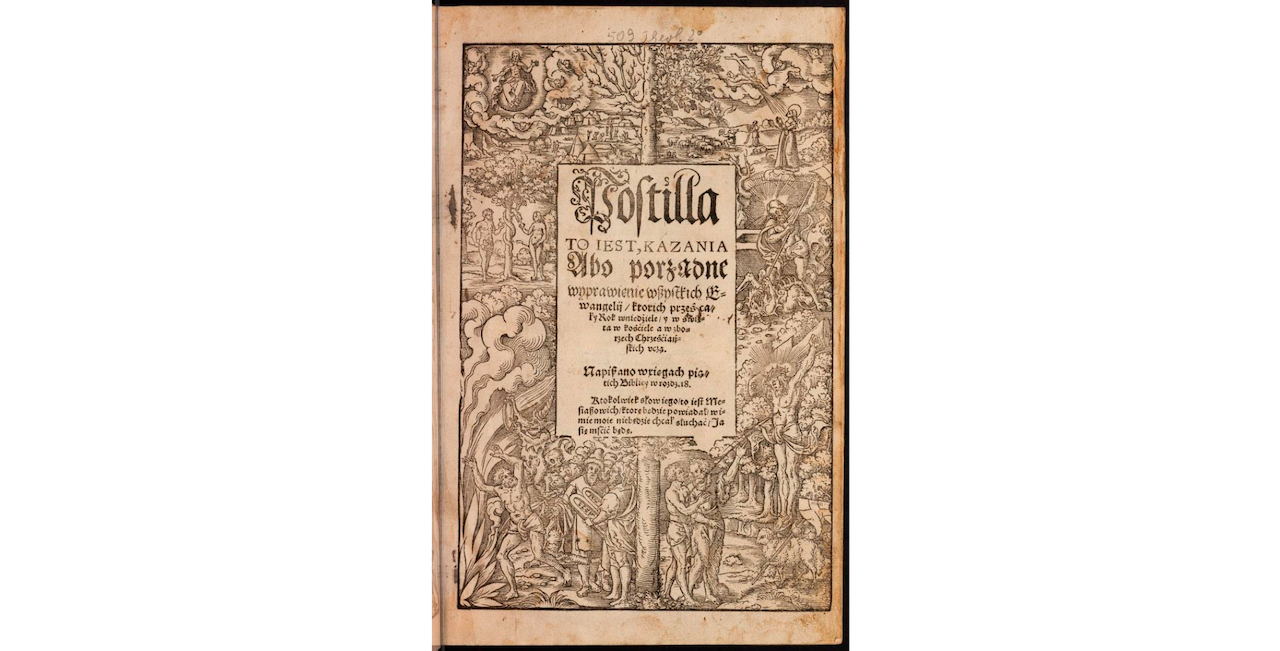
Arsacius Seehofer, Postylla, Eustachy Trepka (translator), Königsberg: Hans Daubmann (printer), 1556 (HAB, Wolfenbüttel)
Explore in ThingsSee Grażyna Jurkowlaniec and Magdalena. Herman. 2021. “Szesnastowieczny królewiecki druk w Herzog August Bibliothek w Wolfenbüttel: ilustracje, oprawa i właściciele” Biuletyn Historii Sztuki 83(2), 285–321
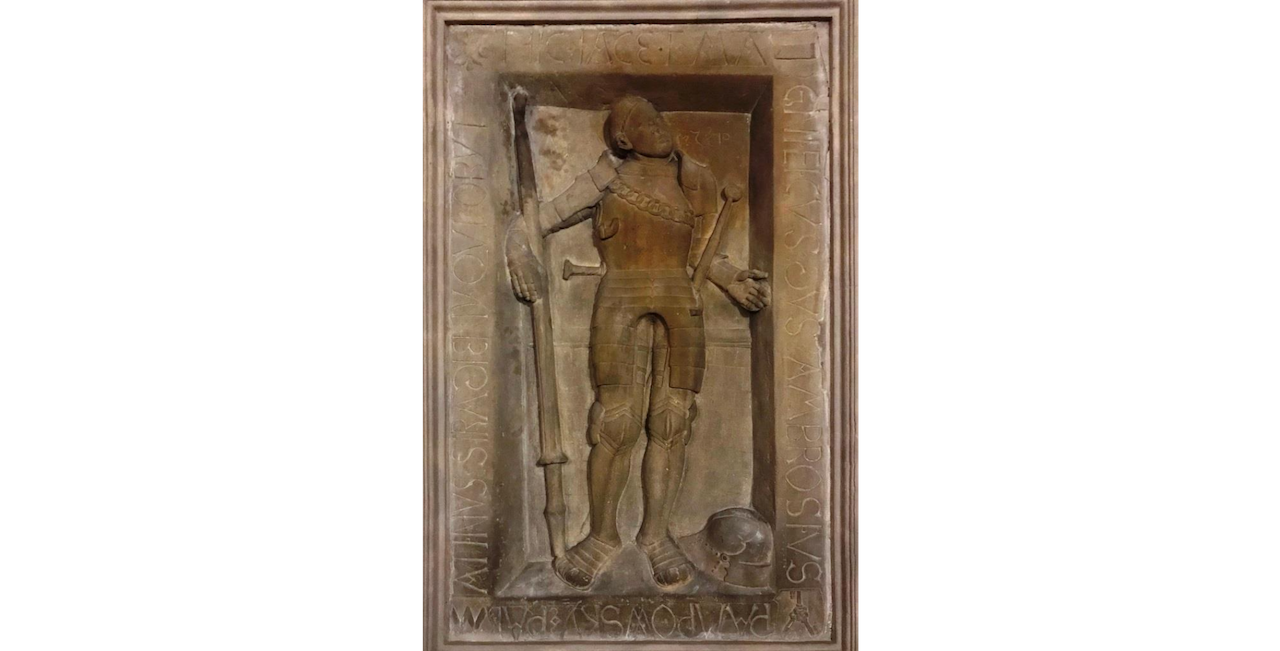
Tombstone of Ambroży Pampowski, (Collegiate church of the Assumption of the Blessed Virgin Mary, Środa Wielkopolska)
Explore in ThingsSee Joanna Sikorska. 2019. “Św. Jerzy z Wielkopolski. Meandry recepcji miedziorytu Albrechta Dürera” Biuletyn Historii Sztuki 81(1), 5–28
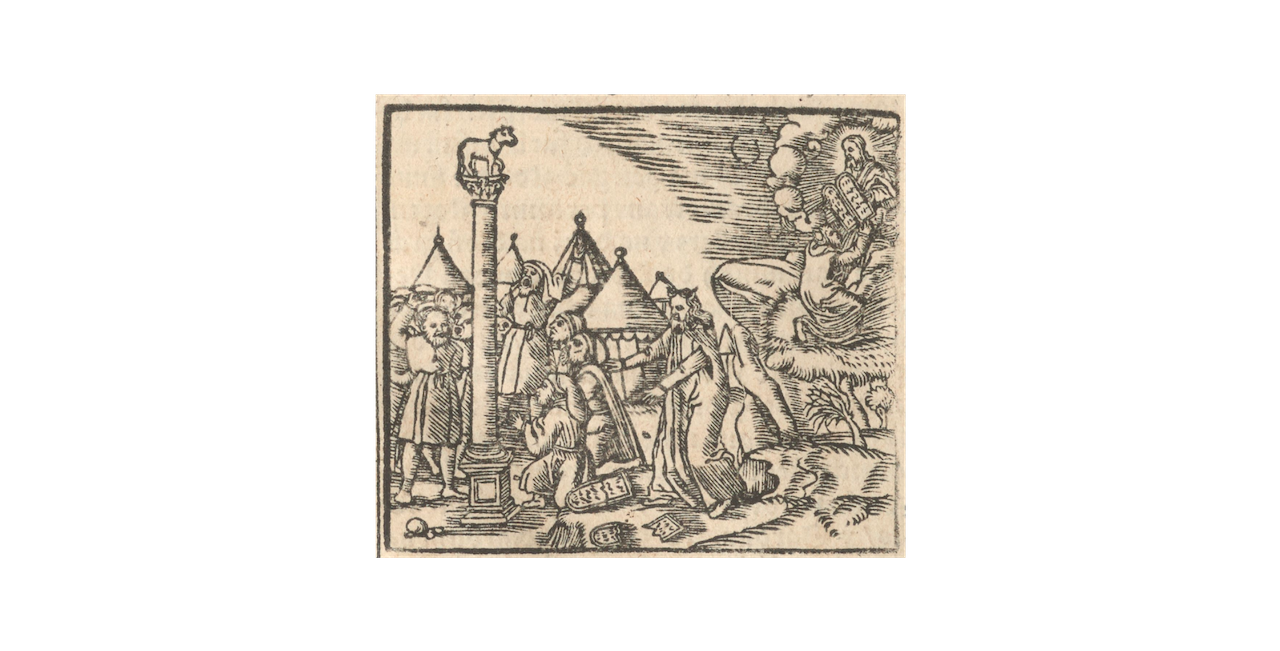
Adoration of the Golden Calf, In Marcin Bielski, Kronika to jest historia świata, Cracow: Mateusz Siebeneicher (printer), 1564 (BCzart, MNK, Cracow)
Explore in ThingsSee Marcin Bogusz. 2022. “Wyposażenie graficzne Kroniki wszystkiego świata Marcina Bielskiego (1554, 1564). Pierwowzory, praktyka i strategia wydawnicza” Biuletyn Historii Sztuki 84(1), 5–41
Since 2019, Urus has been continuing its explorations, focusing for the most part on woodcut illustrations produced in the Polish–Lithuanian Commonwealth of the sixteenth and early seventeenth centuries. The conclusions from these investigations are yet to be drawn. Meanwhile, however, Urus occasionally ventures into various more remote areas, and the tokens from these journeys are:
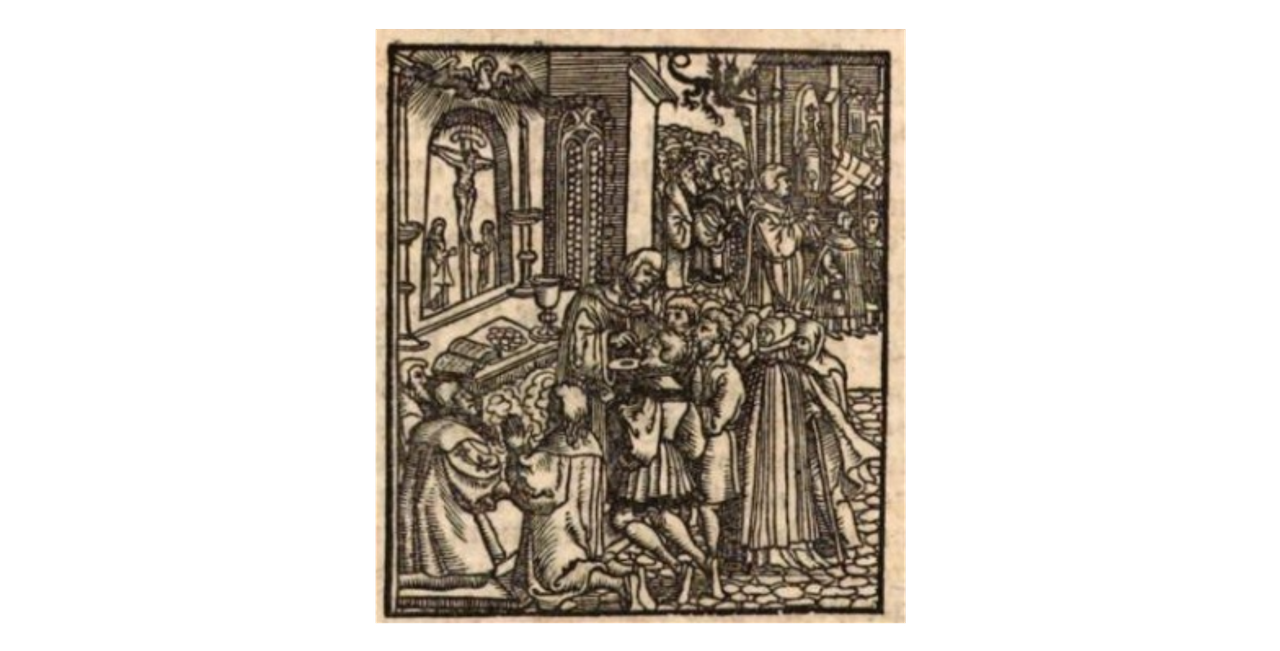
Holy Communion and Procession. In Martin Luther. Haußpostil, Nuremberg: Ulrich Neuber (printer), Johann vom Berg (printer), 1544 (BSB, Munich)
Explore in Things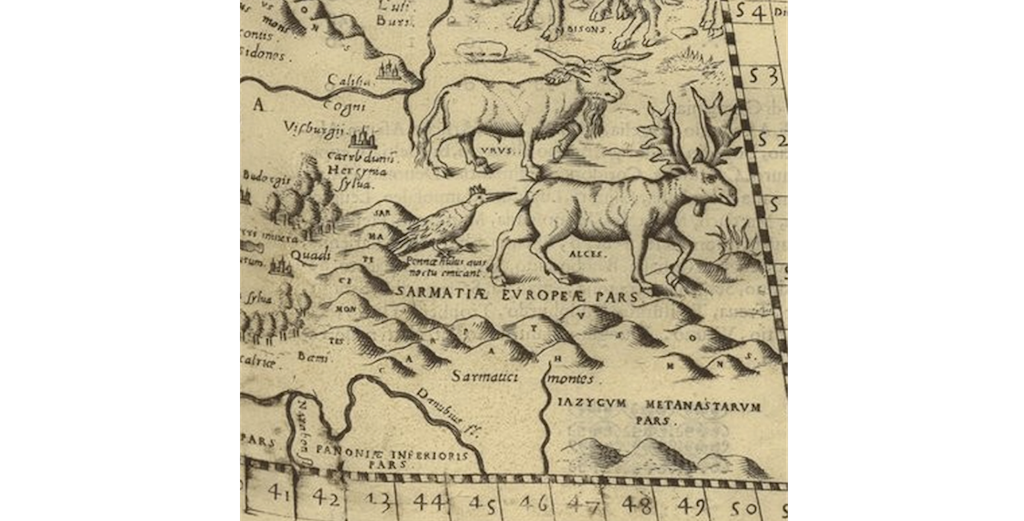
Livio Sanuto (designer), Giulio Sanuto (printmaker), Tabula Europae IIII. In Geografia di Claudio Tolomeo Alessandrino. Girolamo Ruscelli (translator), Venice: Melchior Sessa (heirs) (printer), 1599 (BnF, Paris)
Explore in ThingsComplete list of publications
Jurkowlaniec, Grażyna. 2016. “An Encyclopaedia of the Catholic Faith dedicated to the Archbishop of Salzburg Mark Sittich von Hohenems: an unknown engraving by Natale Bonifacio and Gijsbert van Veen republished by Giacomo Lauro” Barockberichte 64, 66–78.
----- 2017. “Geneza i recepcja drzeworytów na kartach tytułowych kazań Lutra o sakramentach z 1519 roku” Rocznik Historii Sztuki 42: 21-42; expanded version in English: “Reused Matrices, Adopted Iconographies and Misleading Images: Woodcuts on the Title Pages of Luther's Early Sermons on the Sacraments” In Print Culture at the Crossroads The Book and Central Europe. Edited by Elizabeth Dillenburg, Howard Louthan, Drew B. Thomas. Leiden: Brill, 2021, pp. 215–244.
----- 2017. “Konflikt wartości, wspólnota tradycji i pragmatyka rzemiosła: szesnastowieczne wydania Biblii Lutra jako źródła ilustracji Biblii Leopolity” In Luteranizm w kulturze Pierwszej Rzeczypospolitej. Edited by Katarzyna Meller. Warsaw: Wydawnictwa Uniwersytetu Warszawskiego, pp. 323–345.
----- 2017. “Konfessionelle Bilder? Die Lutherbibel und die Bibelillustrationen des 16. Jahrhunderts in Polen” In Der Luthereffekt im östlichen Europa. Geschichte, Kultur, Erinnerung. Edited by Joachim Bahlcke, Beate Störtkuhl and Matthias Weber. Berlin: De Gruyter Oldenbourg, pp. 197–209; English version: “Confessional Images? The Luther Bible and Sixteenth-Century Biblical Illustrations in Poland“ In The Luther Effect in Eastern Europe: History, Culture, Memory. Edited by Joachim Bahlcke, Beate Störtkuhl and Matthias Weber. Berlin: DeGruyter Oldenbourg, 2017, pp. 197–209.
----- 2020. “Early Engravings by Giacomo Lauro Published by Claudio Duchetti” Print Quarterly 37(1): 3–14.
----- 2020. “Wilczy pasterze i smoczy ogon. Przestroga przed fałszywymi prorokami w postylli Mikołaja Reja” In Z historii kultury staropolskiej. Studia ofiarowane Urszuli Augustyniak. Edited by Agnieszka Bartoszewicz, Andrzej Karpiński, Maciej Ptaszyński and Andrzej Zakrzewski. Warsaw: Wydawnictwa Uniwersytetu Warszawskiego, pp. 204–219.
----- 2019. “Św. Jerzy z Wielkopolski. Meandry recepcji miedziorytu Albrechta Dürera” Biuletyn Historii Sztuki 81(1), 5–28; English version: “Saint George from Greater Poland: Complexities of the Reception of Albrecht Dürer’s Engraving” In The Reception of the Printed Image in the Fifteenth and Sixteenth Centuries. Multiplied and Modified. Edited by Grażyna Jurkowlaniec and Magdalena Herman. New York: Routledge, 2020, pp. 195–212.
----- 2020. “Obraz grafiki. Forma i funkcja rycin z perspektywy malarzy niderlandzkich XV i początku XVI wieku / The Image of the Print. The Form and Function of Graphic Art in the Eyes of Netherlandish Painters from the 15th and early 16th Century“ In Hans Memling i sztuka dewocji osobistej w Niderlandach w XV i początku XVI wieku. Edited by Marcin Kaleciński. Gdańsk 2020, pp. 123–133.
Urus staff
Head Keeper: Grażyna Jurkowlaniec (University of Warsaw), since 2016
Senior Caretakers: Marcin Bogusz (National Museum in Warsaw), since 2016; Magdalena Herman (University of Warsaw), since 2016; Wojciech Kordyzon (University of Warsaw), since 2020
Junior Caretakers: Martyna Osuch (University of Warsaw), since 2023; Barbara Dzierżanowska (University of Warsaw), since 2025; Christina Anne Stackpole (University of Warsaw), since 2025
Mechanics (and Veterinarians): Piotr Kasprzyk (Digital Competence Centre, University of Warsaw), since 2019; Tomasz Sporczyk (Digital Competence Centre, University of Warsaw), since 2019, Wojciech Karpiński (Digital Competence Centre, University of Warsaw), since 2024
Groomer: Aleksandra Fedorowicz-Jackowska, since 2016
Advisors: Joanna Sikorska (National Museum in Warsaw); Karolina Mroziewicz (University of Warsaw)
Security Guard: Dominik Purchała (Digital Competence Centre, University of Warsaw)
Past staff members: Piotr Kopszak (National Museum in Warsaw), mechanic 2016–2019; Agnieszka Dziki (University of Warsaw), caretaker 2019–2022; Konrad Morawski (University of Warsaw), caretaker 2019–2022; Marek Płuciniczak (University of Warsaw and National Museum in Warsaw), caretaker 2016–2019; Wojciech Milej (University of Warsaw), caretaker 2022–2023; Marta Pełszyk (University of Warsaw), caretaker 2023; Adam Perzyński (University of Warsaw), caretaker 2021–2023; Anna Suchecka (University of Maria Curie-Skłodowska, Lublin), caretaker 2022–2024; Dariusz Żyto (University of Warsaw), caretaker 2023–2024.